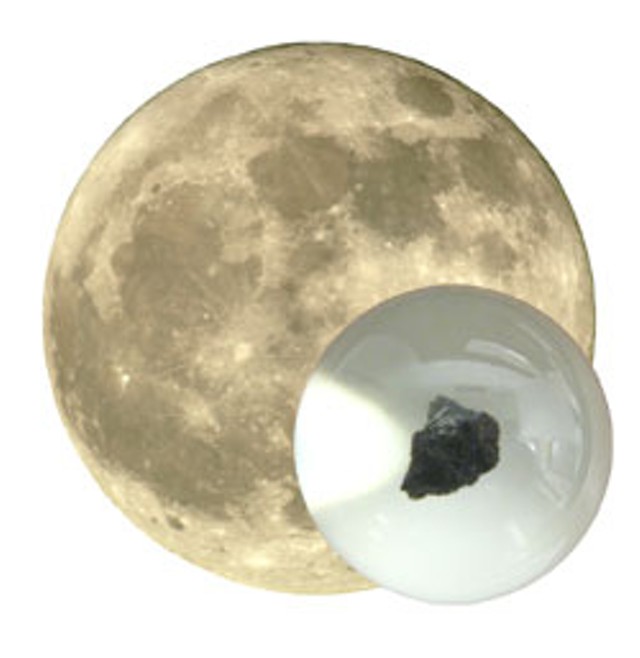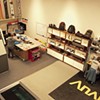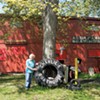Published March 17, 2010 at 9:23 a.m.
According to a recent piece in the venerable National Geographic, our world is in crisis. No, not because the Earth is becoming warmer or because we can’t stop killing each other, but because of the dearth of Moon rocks. Yes, just as redheads are edging toward extinction (another Natty Geo factoid), Moon rocks are also going the way of the dodo. The dwindling cache of lunar stones means that scientists and collectors are out of luck until we make another trip to the Moon.
During the Apollo lunar missions conducted between 1969 and 1972, fearless astronauts-cum-prospectors hauled back some 842 pounds of rocks. NASA kept much of that rubble for research (recently, its scientists detected water molecules inside the rocks), but some of the rocks were given out as gestures of “peace” and “harmony.”
These kernel-sized “goodwill Moon rocks,” as they came to be known, were gifted to 134 countries, 50 states and all the U.S. territories. That means Vermont has Moon rocks. These lunar samples can fetch upwards of seven figures on the black market, owing to demand that far exceeds supply, so I wanted to find out what was up with ours. I’ve got a few bills to pay.
When I first read about the state Moon rocks, I imagined Vermont’s sitting on a dusty bookshelf in some bureaucrat’s Montpelier office, perhaps shoehorned between a miniature bottle of maple syrup and a certificate of appreciation from the local Elks Lodge. But, after a few phone calls and a quick Internet search, I discovered that the Moon rocks have been housed in a climate-controlled storage room in the basement of the Vermont History Center since President Nixon sent them to us 40 years ago.
I called Jackie Calder, curator of all things Vermontiana at the Barre facility, to see if I could get a look at these geological wonders. And by “get a look,” I mean pocket them and sell them for big cash.
Calder was down — at least with the looking part. On a recent sunny afternoon, she took me into the windowless bowels of the history center and introduced me to the residents of shelf 003/10/3c.
I was underwhelmed, to say the least. Instead of revealing a boulder-sized chunk of the Moon, Calder offered up a wooden plaque on a pedestal. Mounted on the plaque was a plastic-encased flag the size of a toilet-paper square and an acrylic marble impregnated with four pebbles. The pebbles — technically, 50 milligrams of Moon dust split into four bits — were each roughly the size of a piece of food that gets stuck between one’s teeth. This was one of the Moon rocks, Calder said, a gift from Tricky Dick.
The other rock, this one courtesy of NASA, was similar to the first, except the plaque had no pedestal. Also, this Lucite-swaddled Moon rock was slightly larger — about the size of a chewed-up wad of gum.
Below the Lucite orb ran the following inscription: “This fragment is a portion of a rock from the Taurus-Littrow Valley of the Moon. It was part of a larger rock composed of many particles of different shapes and sizes, a symbol of the unity of human endeavor and mankind’s hope for a future of peace and harmony.”
“NASA had a good PR department,” Calder quipped.
Despite the puniness of the rock slivers, there’s something cool about the fact that pieces of the Moon reside here in Vermont — and will forever remain here, unless they are stolen. The Vermont History Center can neither give them away nor sell them to help plug holes in the state budget. In the United States, it is illegal to transfer ownership of public gifts such as the Moon rocks without permission from an act of Congress. That’s why the rocks are worth so much — it’s nearly impossible to get your hands on one.
At least Vermont can boast of possessing these little extraterrestrial bits, even if they’re rarely displayed and live among the antique swords, early ceramic ware and Ethan Allen-era outfits in the center’s 20,000-piece collection. Many states’ gifted Moon rocks are actually unaccounted for: Kentucky, New Mexico and South Carolina are just a few of the irresponsible states that have lost their lunar prezzies. Chances are that come 2018, the year NASA plans to undertake its first manned lunar landing since Apollo, they won’t be getting replacements.
Fill out my online form.
More By This Author
Speaking of Culture,
-

Video: Musicians Jeremiah and Annemieke McLane Move into their New Home
Mar 24, 2022 -

Creating Art That Celebrates the Culture and Climate of Places Around the Globe
Jun 29, 2021 -

Video: Storyteller Ferene Paris Meyer Inspires a Juneteenth Mural
Jun 17, 2021 -

Arts and Culture Nonprofits to Receive $5 Million in State Relief Grants
Jul 7, 2020 -

18 Elm in Waterbury Creates Community at the Table
Jul 9, 2019 - More »
Comments
Comments are closed.
From 2014-2020, Seven Days allowed readers to comment on all stories posted on our website. While we've appreciated the suggestions and insights, right now Seven Days is prioritizing our core mission — producing high-quality, responsible local journalism — over moderating online debates between readers.
To criticize, correct or praise our reporting, please send us a letter to the editor or send us a tip. We’ll check it out and report the results.
Online comments may return when we have better tech tools for managing them. Thanks for reading.














































